Analyzing Change: Leadership and Strategy in Coca-Cola and Amazon
VerifiedAdded on 2020/06/04
|12
|3451
|32
Report
AI Summary
This report provides a comprehensive analysis of change management strategies within Coca-Cola and Amazon, examining how these companies adapt to internal and external drivers of change. The report delves into the impact of change on company strategy and operations, comparing the approaches of both organizations. It explores the diverse ways internal and external factors influence change, including customer-led, technology-led, and competitor-led drivers. Furthermore, the report evaluates measures to mitigate the adverse effects of change on firm behavior, such as the system theory and the PDCA cycle. It also identifies barriers to change and their influence on leadership decision-making, along with various leadership approaches to address organizational changes. The report highlights the importance of change management tools and strategies for maintaining competitiveness and achieving sustainable development, providing valuable insights for understanding and leading change in dynamic business environments.
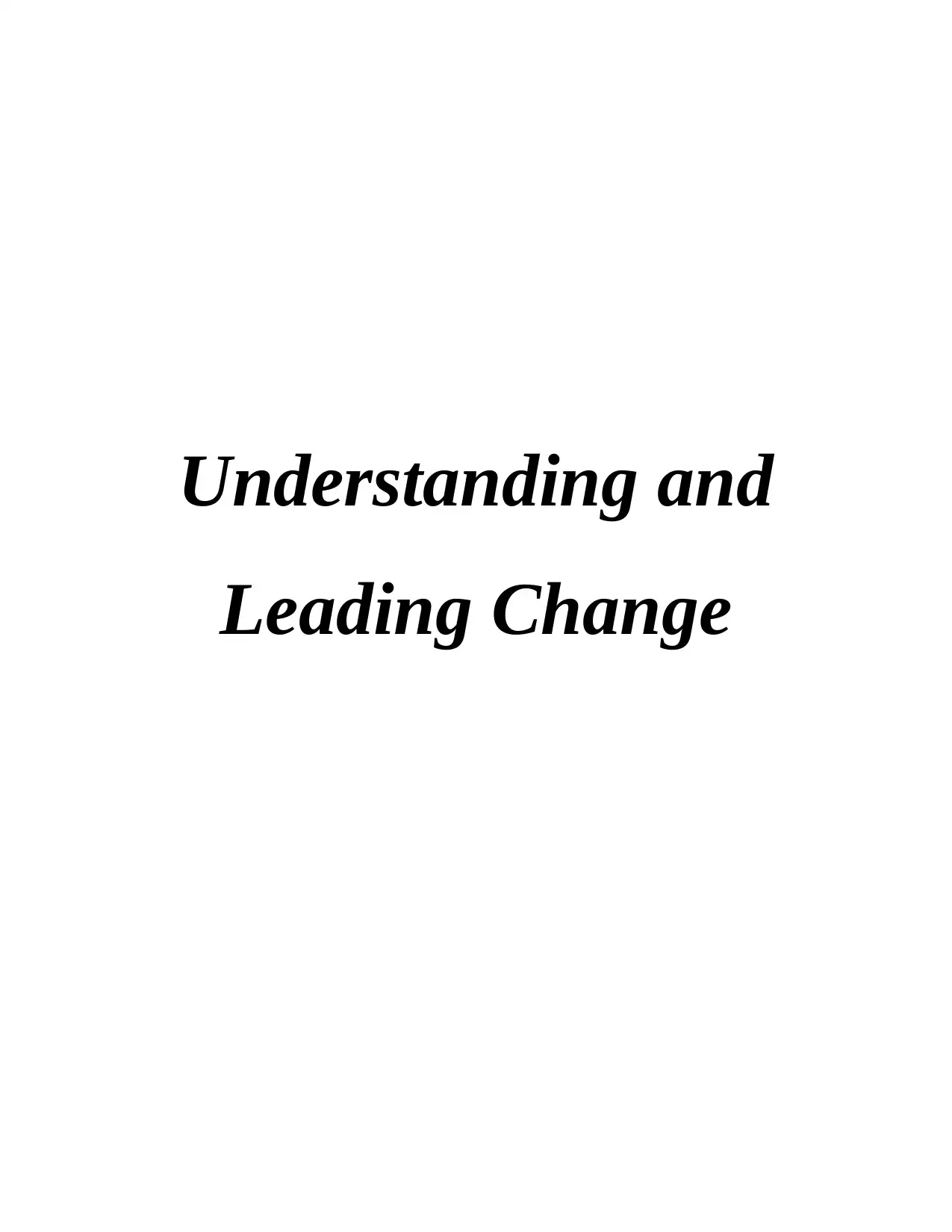
Understanding and
Leading Change
Leading Change
Paraphrase This Document
Need a fresh take? Get an instant paraphrase of this document with our AI Paraphraser
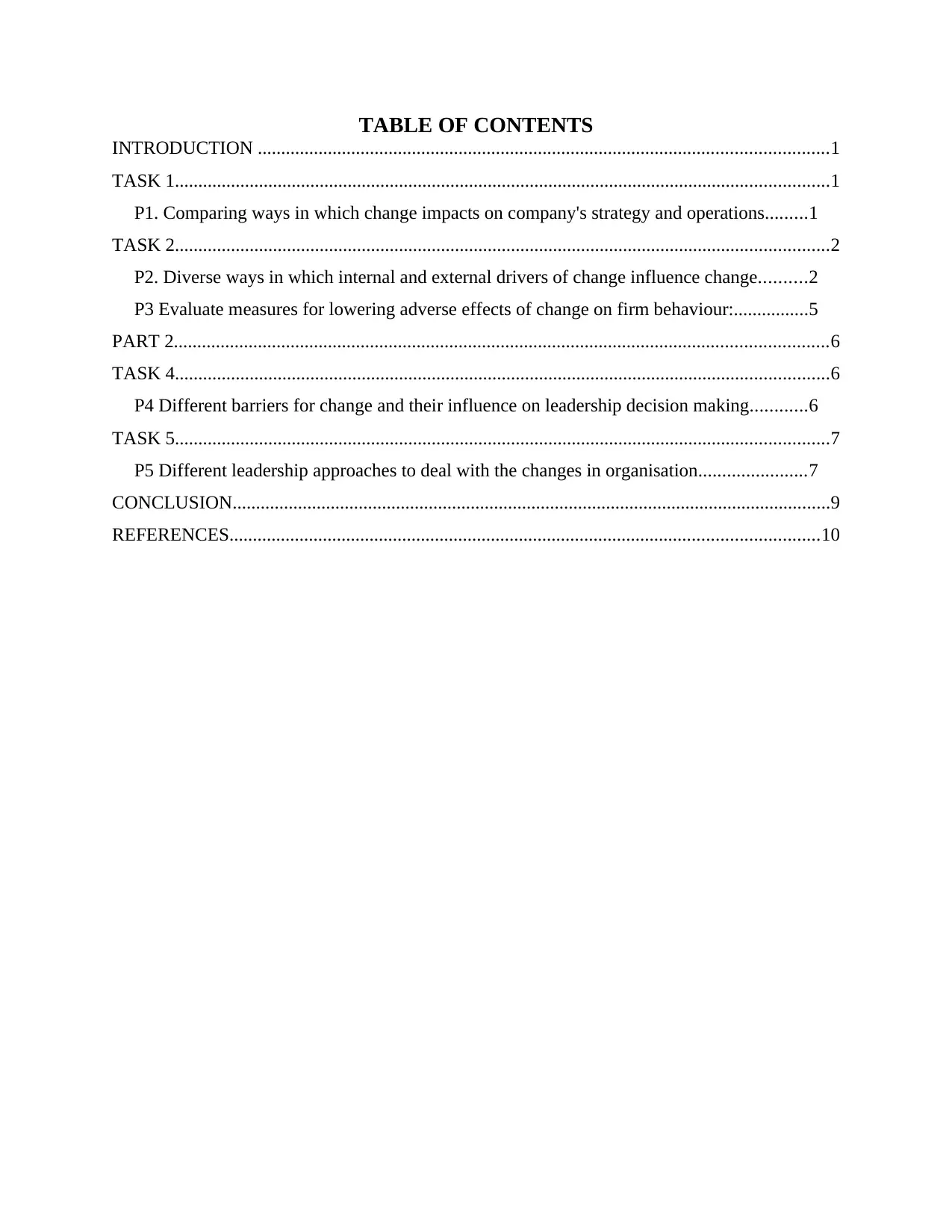
TABLE OF CONTENTS
INTRODUCTION ..........................................................................................................................1
TASK 1............................................................................................................................................1
P1. Comparing ways in which change impacts on company's strategy and operations.........1
TASK 2............................................................................................................................................2
P2. Diverse ways in which internal and external drivers of change influence change..........2
P3 Evaluate measures for lowering adverse effects of change on firm behaviour:................5
PART 2............................................................................................................................................6
TASK 4............................................................................................................................................6
P4 Different barriers for change and their influence on leadership decision making............6
TASK 5............................................................................................................................................7
P5 Different leadership approaches to deal with the changes in organisation.......................7
CONCLUSION................................................................................................................................9
REFERENCES..............................................................................................................................10
INTRODUCTION ..........................................................................................................................1
TASK 1............................................................................................................................................1
P1. Comparing ways in which change impacts on company's strategy and operations.........1
TASK 2............................................................................................................................................2
P2. Diverse ways in which internal and external drivers of change influence change..........2
P3 Evaluate measures for lowering adverse effects of change on firm behaviour:................5
PART 2............................................................................................................................................6
TASK 4............................................................................................................................................6
P4 Different barriers for change and their influence on leadership decision making............6
TASK 5............................................................................................................................................7
P5 Different leadership approaches to deal with the changes in organisation.......................7
CONCLUSION................................................................................................................................9
REFERENCES..............................................................................................................................10
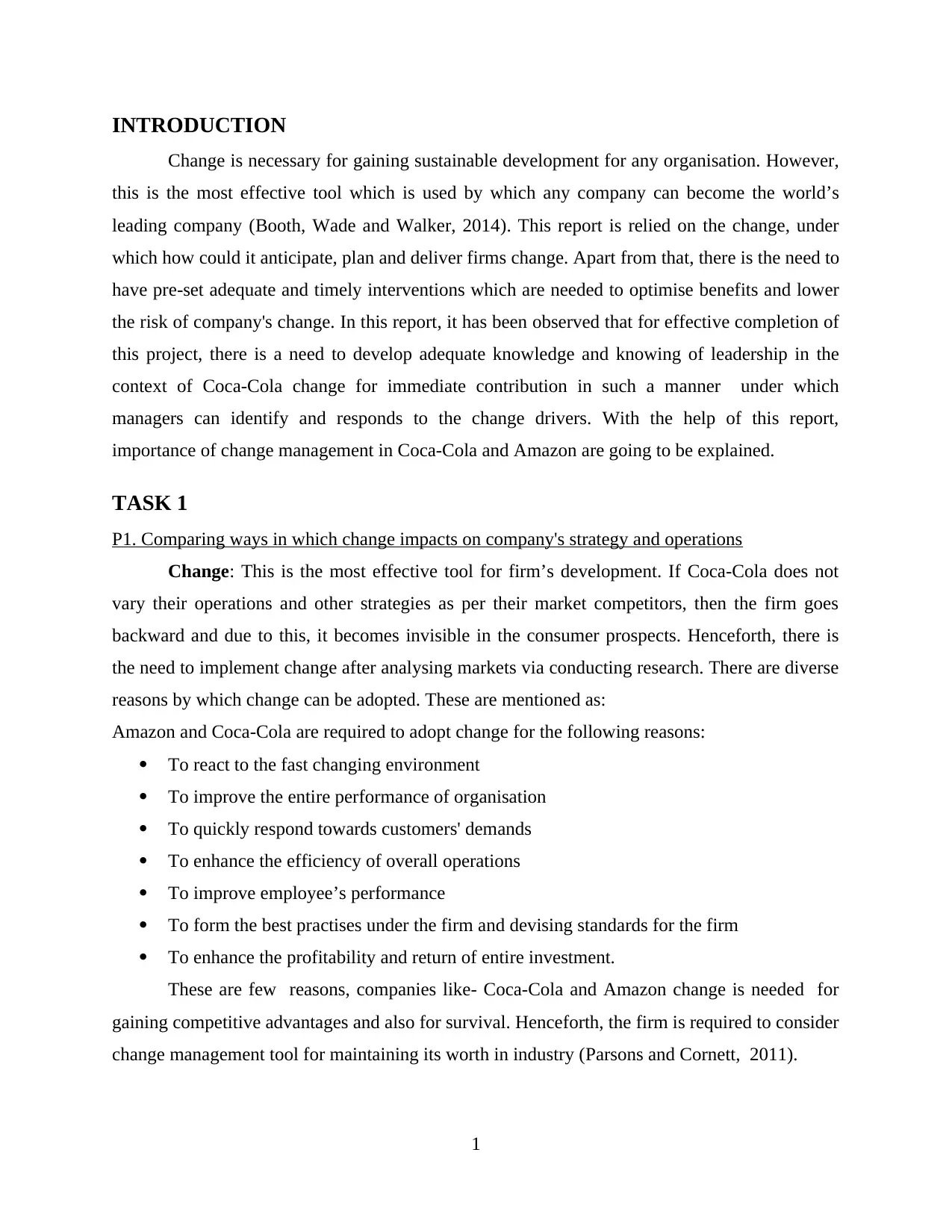
INTRODUCTION
Change is necessary for gaining sustainable development for any organisation. However,
this is the most effective tool which is used by which any company can become the world’s
leading company (Booth, Wade and Walker, 2014). This report is relied on the change, under
which how could it anticipate, plan and deliver firms change. Apart from that, there is the need to
have pre-set adequate and timely interventions which are needed to optimise benefits and lower
the risk of company's change. In this report, it has been observed that for effective completion of
this project, there is a need to develop adequate knowledge and knowing of leadership in the
context of Coca-Cola change for immediate contribution in such a manner under which
managers can identify and responds to the change drivers. With the help of this report,
importance of change management in Coca-Cola and Amazon are going to be explained.
TASK 1
P1. Comparing ways in which change impacts on company's strategy and operations
Change: This is the most effective tool for firm’s development. If Coca-Cola does not
vary their operations and other strategies as per their market competitors, then the firm goes
backward and due to this, it becomes invisible in the consumer prospects. Henceforth, there is
the need to implement change after analysing markets via conducting research. There are diverse
reasons by which change can be adopted. These are mentioned as:
Amazon and Coca-Cola are required to adopt change for the following reasons:
To react to the fast changing environment
To improve the entire performance of organisation
To quickly respond towards customers' demands
To enhance the efficiency of overall operations
To improve employee’s performance
To form the best practises under the firm and devising standards for the firm
To enhance the profitability and return of entire investment.
These are few reasons, companies like- Coca-Cola and Amazon change is needed for
gaining competitive advantages and also for survival. Henceforth, the firm is required to consider
change management tool for maintaining its worth in industry (Parsons and Cornett, 2011).
1
Change is necessary for gaining sustainable development for any organisation. However,
this is the most effective tool which is used by which any company can become the world’s
leading company (Booth, Wade and Walker, 2014). This report is relied on the change, under
which how could it anticipate, plan and deliver firms change. Apart from that, there is the need to
have pre-set adequate and timely interventions which are needed to optimise benefits and lower
the risk of company's change. In this report, it has been observed that for effective completion of
this project, there is a need to develop adequate knowledge and knowing of leadership in the
context of Coca-Cola change for immediate contribution in such a manner under which
managers can identify and responds to the change drivers. With the help of this report,
importance of change management in Coca-Cola and Amazon are going to be explained.
TASK 1
P1. Comparing ways in which change impacts on company's strategy and operations
Change: This is the most effective tool for firm’s development. If Coca-Cola does not
vary their operations and other strategies as per their market competitors, then the firm goes
backward and due to this, it becomes invisible in the consumer prospects. Henceforth, there is
the need to implement change after analysing markets via conducting research. There are diverse
reasons by which change can be adopted. These are mentioned as:
Amazon and Coca-Cola are required to adopt change for the following reasons:
To react to the fast changing environment
To improve the entire performance of organisation
To quickly respond towards customers' demands
To enhance the efficiency of overall operations
To improve employee’s performance
To form the best practises under the firm and devising standards for the firm
To enhance the profitability and return of entire investment.
These are few reasons, companies like- Coca-Cola and Amazon change is needed for
gaining competitive advantages and also for survival. Henceforth, the firm is required to consider
change management tool for maintaining its worth in industry (Parsons and Cornett, 2011).
1
⊘ This is a preview!⊘
Do you want full access?
Subscribe today to unlock all pages.

Trusted by 1+ million students worldwide
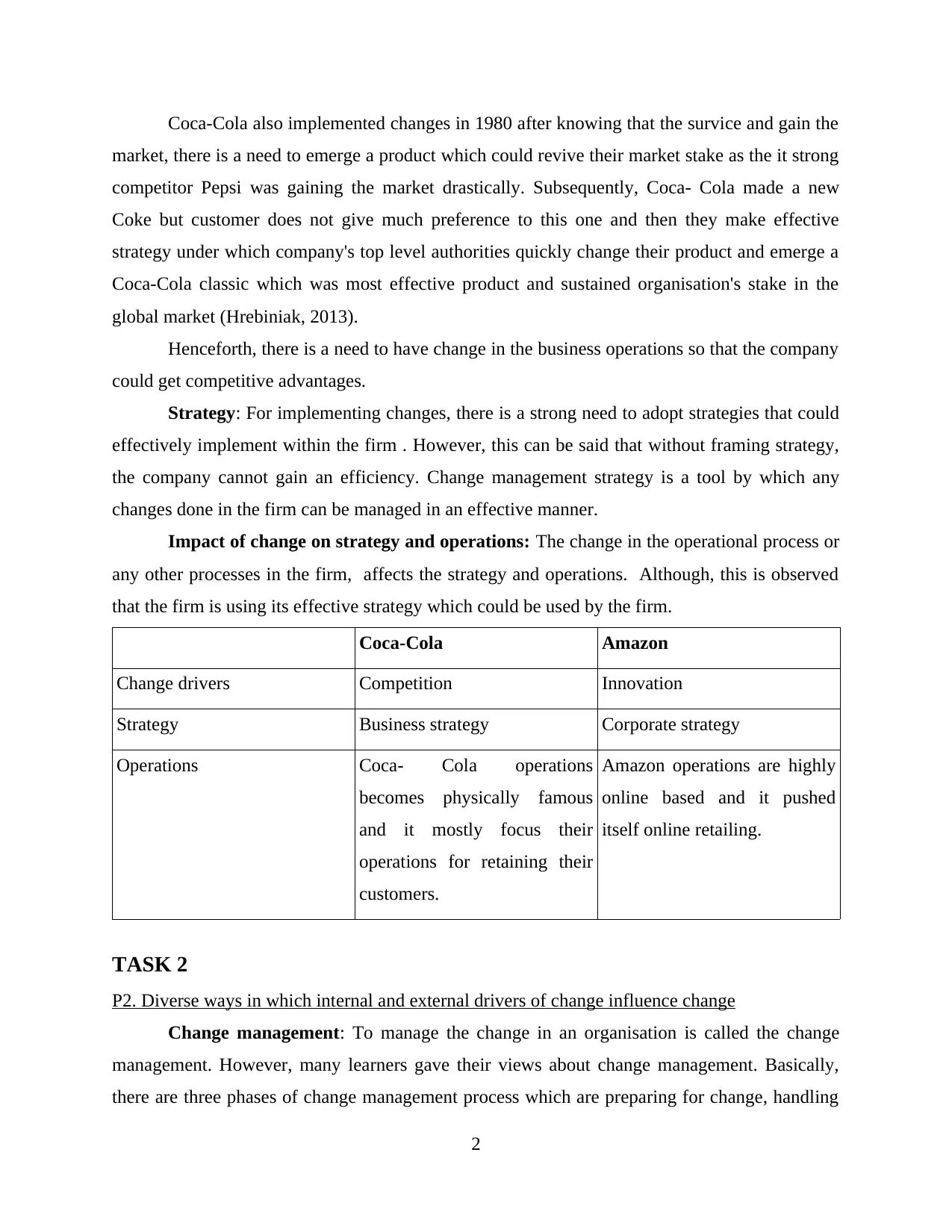
Coca-Cola also implemented changes in 1980 after knowing that the survice and gain the
market, there is a need to emerge a product which could revive their market stake as the it strong
competitor Pepsi was gaining the market drastically. Subsequently, Coca- Cola made a new
Coke but customer does not give much preference to this one and then they make effective
strategy under which company's top level authorities quickly change their product and emerge a
Coca-Cola classic which was most effective product and sustained organisation's stake in the
global market (Hrebiniak, 2013).
Henceforth, there is a need to have change in the business operations so that the company
could get competitive advantages.
Strategy: For implementing changes, there is a strong need to adopt strategies that could
effectively implement within the firm . However, this can be said that without framing strategy,
the company cannot gain an efficiency. Change management strategy is a tool by which any
changes done in the firm can be managed in an effective manner.
Impact of change on strategy and operations: The change in the operational process or
any other processes in the firm, affects the strategy and operations. Although, this is observed
that the firm is using its effective strategy which could be used by the firm.
Coca-Cola Amazon
Change drivers Competition Innovation
Strategy Business strategy Corporate strategy
Operations Coca- Cola operations
becomes physically famous
and it mostly focus their
operations for retaining their
customers.
Amazon operations are highly
online based and it pushed
itself online retailing.
TASK 2
P2. Diverse ways in which internal and external drivers of change influence change
Change management: To manage the change in an organisation is called the change
management. However, many learners gave their views about change management. Basically,
there are three phases of change management process which are preparing for change, handling
2
market, there is a need to emerge a product which could revive their market stake as the it strong
competitor Pepsi was gaining the market drastically. Subsequently, Coca- Cola made a new
Coke but customer does not give much preference to this one and then they make effective
strategy under which company's top level authorities quickly change their product and emerge a
Coca-Cola classic which was most effective product and sustained organisation's stake in the
global market (Hrebiniak, 2013).
Henceforth, there is a need to have change in the business operations so that the company
could get competitive advantages.
Strategy: For implementing changes, there is a strong need to adopt strategies that could
effectively implement within the firm . However, this can be said that without framing strategy,
the company cannot gain an efficiency. Change management strategy is a tool by which any
changes done in the firm can be managed in an effective manner.
Impact of change on strategy and operations: The change in the operational process or
any other processes in the firm, affects the strategy and operations. Although, this is observed
that the firm is using its effective strategy which could be used by the firm.
Coca-Cola Amazon
Change drivers Competition Innovation
Strategy Business strategy Corporate strategy
Operations Coca- Cola operations
becomes physically famous
and it mostly focus their
operations for retaining their
customers.
Amazon operations are highly
online based and it pushed
itself online retailing.
TASK 2
P2. Diverse ways in which internal and external drivers of change influence change
Change management: To manage the change in an organisation is called the change
management. However, many learners gave their views about change management. Basically,
there are three phases of change management process which are preparing for change, handling
2
Paraphrase This Document
Need a fresh take? Get an instant paraphrase of this document with our AI Paraphraser
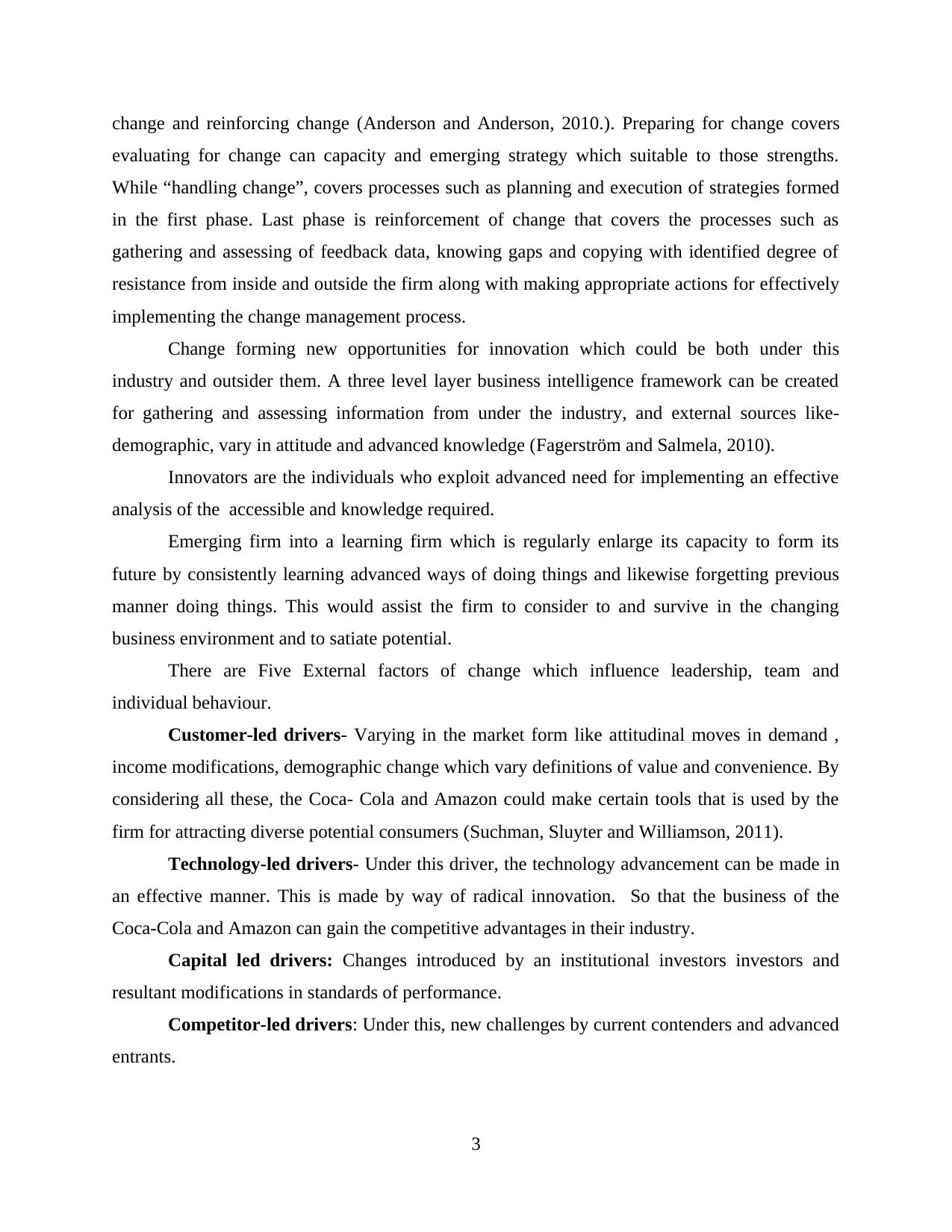
change and reinforcing change (Anderson and Anderson, 2010.). Preparing for change covers
evaluating for change can capacity and emerging strategy which suitable to those strengths.
While “handling change”, covers processes such as planning and execution of strategies formed
in the first phase. Last phase is reinforcement of change that covers the processes such as
gathering and assessing of feedback data, knowing gaps and copying with identified degree of
resistance from inside and outside the firm along with making appropriate actions for effectively
implementing the change management process.
Change forming new opportunities for innovation which could be both under this
industry and outsider them. A three level layer business intelligence framework can be created
for gathering and assessing information from under the industry, and external sources like-
demographic, vary in attitude and advanced knowledge (Fagerström and Salmela, 2010).
Innovators are the individuals who exploit advanced need for implementing an effective
analysis of the accessible and knowledge required.
Emerging firm into a learning firm which is regularly enlarge its capacity to form its
future by consistently learning advanced ways of doing things and likewise forgetting previous
manner doing things. This would assist the firm to consider to and survive in the changing
business environment and to satiate potential.
There are Five External factors of change which influence leadership, team and
individual behaviour.
Customer-led drivers- Varying in the market form like attitudinal moves in demand ,
income modifications, demographic change which vary definitions of value and convenience. By
considering all these, the Coca- Cola and Amazon could make certain tools that is used by the
firm for attracting diverse potential consumers (Suchman, Sluyter and Williamson, 2011).
Technology-led drivers- Under this driver, the technology advancement can be made in
an effective manner. This is made by way of radical innovation. So that the business of the
Coca-Cola and Amazon can gain the competitive advantages in their industry.
Capital led drivers: Changes introduced by an institutional investors investors and
resultant modifications in standards of performance.
Competitor-led drivers: Under this, new challenges by current contenders and advanced
entrants.
3
evaluating for change can capacity and emerging strategy which suitable to those strengths.
While “handling change”, covers processes such as planning and execution of strategies formed
in the first phase. Last phase is reinforcement of change that covers the processes such as
gathering and assessing of feedback data, knowing gaps and copying with identified degree of
resistance from inside and outside the firm along with making appropriate actions for effectively
implementing the change management process.
Change forming new opportunities for innovation which could be both under this
industry and outsider them. A three level layer business intelligence framework can be created
for gathering and assessing information from under the industry, and external sources like-
demographic, vary in attitude and advanced knowledge (Fagerström and Salmela, 2010).
Innovators are the individuals who exploit advanced need for implementing an effective
analysis of the accessible and knowledge required.
Emerging firm into a learning firm which is regularly enlarge its capacity to form its
future by consistently learning advanced ways of doing things and likewise forgetting previous
manner doing things. This would assist the firm to consider to and survive in the changing
business environment and to satiate potential.
There are Five External factors of change which influence leadership, team and
individual behaviour.
Customer-led drivers- Varying in the market form like attitudinal moves in demand ,
income modifications, demographic change which vary definitions of value and convenience. By
considering all these, the Coca- Cola and Amazon could make certain tools that is used by the
firm for attracting diverse potential consumers (Suchman, Sluyter and Williamson, 2011).
Technology-led drivers- Under this driver, the technology advancement can be made in
an effective manner. This is made by way of radical innovation. So that the business of the
Coca-Cola and Amazon can gain the competitive advantages in their industry.
Capital led drivers: Changes introduced by an institutional investors investors and
resultant modifications in standards of performance.
Competitor-led drivers: Under this, new challenges by current contenders and advanced
entrants.
3
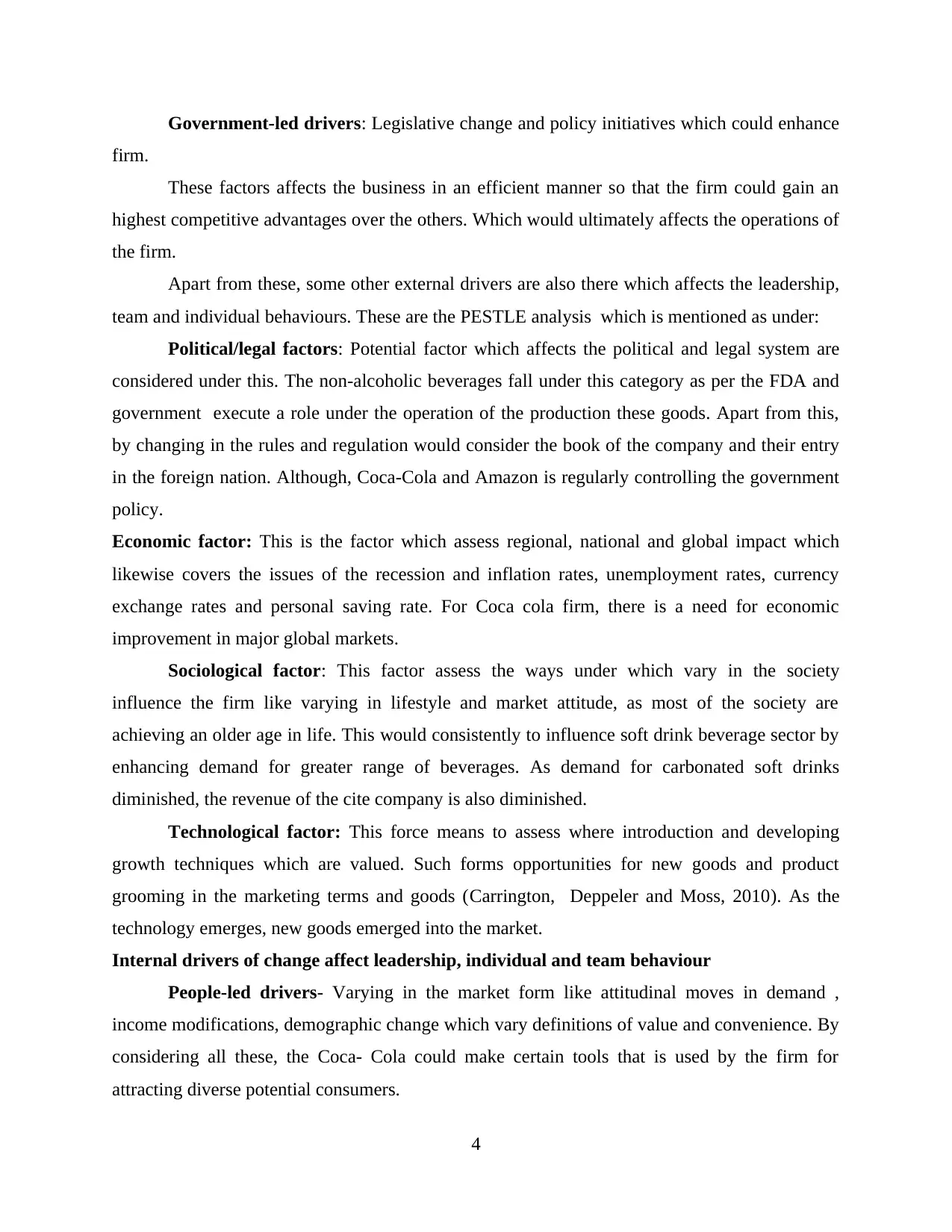
Government-led drivers: Legislative change and policy initiatives which could enhance
firm.
These factors affects the business in an efficient manner so that the firm could gain an
highest competitive advantages over the others. Which would ultimately affects the operations of
the firm.
Apart from these, some other external drivers are also there which affects the leadership,
team and individual behaviours. These are the PESTLE analysis which is mentioned as under:
Political/legal factors: Potential factor which affects the political and legal system are
considered under this. The non-alcoholic beverages fall under this category as per the FDA and
government execute a role under the operation of the production these goods. Apart from this,
by changing in the rules and regulation would consider the book of the company and their entry
in the foreign nation. Although, Coca-Cola and Amazon is regularly controlling the government
policy.
Economic factor: This is the factor which assess regional, national and global impact which
likewise covers the issues of the recession and inflation rates, unemployment rates, currency
exchange rates and personal saving rate. For Coca cola firm, there is a need for economic
improvement in major global markets.
Sociological factor: This factor assess the ways under which vary in the society
influence the firm like varying in lifestyle and market attitude, as most of the society are
achieving an older age in life. This would consistently to influence soft drink beverage sector by
enhancing demand for greater range of beverages. As demand for carbonated soft drinks
diminished, the revenue of the cite company is also diminished.
Technological factor: This force means to assess where introduction and developing
growth techniques which are valued. Such forms opportunities for new goods and product
grooming in the marketing terms and goods (Carrington, Deppeler and Moss, 2010). As the
technology emerges, new goods emerged into the market.
Internal drivers of change affect leadership, individual and team behaviour
People-led drivers- Varying in the market form like attitudinal moves in demand ,
income modifications, demographic change which vary definitions of value and convenience. By
considering all these, the Coca- Cola could make certain tools that is used by the firm for
attracting diverse potential consumers.
4
firm.
These factors affects the business in an efficient manner so that the firm could gain an
highest competitive advantages over the others. Which would ultimately affects the operations of
the firm.
Apart from these, some other external drivers are also there which affects the leadership,
team and individual behaviours. These are the PESTLE analysis which is mentioned as under:
Political/legal factors: Potential factor which affects the political and legal system are
considered under this. The non-alcoholic beverages fall under this category as per the FDA and
government execute a role under the operation of the production these goods. Apart from this,
by changing in the rules and regulation would consider the book of the company and their entry
in the foreign nation. Although, Coca-Cola and Amazon is regularly controlling the government
policy.
Economic factor: This is the factor which assess regional, national and global impact which
likewise covers the issues of the recession and inflation rates, unemployment rates, currency
exchange rates and personal saving rate. For Coca cola firm, there is a need for economic
improvement in major global markets.
Sociological factor: This factor assess the ways under which vary in the society
influence the firm like varying in lifestyle and market attitude, as most of the society are
achieving an older age in life. This would consistently to influence soft drink beverage sector by
enhancing demand for greater range of beverages. As demand for carbonated soft drinks
diminished, the revenue of the cite company is also diminished.
Technological factor: This force means to assess where introduction and developing
growth techniques which are valued. Such forms opportunities for new goods and product
grooming in the marketing terms and goods (Carrington, Deppeler and Moss, 2010). As the
technology emerges, new goods emerged into the market.
Internal drivers of change affect leadership, individual and team behaviour
People-led drivers- Varying in the market form like attitudinal moves in demand ,
income modifications, demographic change which vary definitions of value and convenience. By
considering all these, the Coca- Cola could make certain tools that is used by the firm for
attracting diverse potential consumers.
4
⊘ This is a preview!⊘
Do you want full access?
Subscribe today to unlock all pages.

Trusted by 1+ million students worldwide
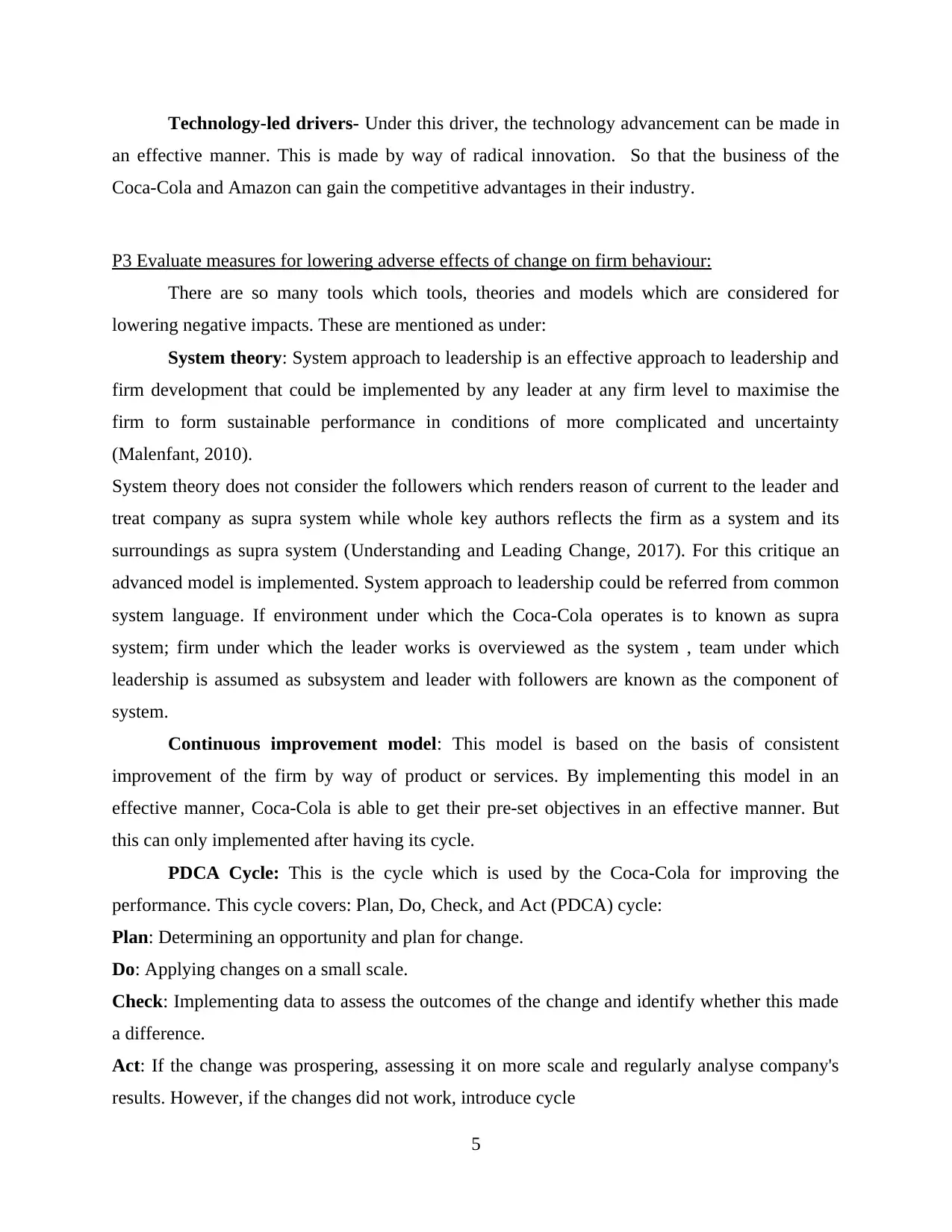
Technology-led drivers- Under this driver, the technology advancement can be made in
an effective manner. This is made by way of radical innovation. So that the business of the
Coca-Cola and Amazon can gain the competitive advantages in their industry.
P3 Evaluate measures for lowering adverse effects of change on firm behaviour:
There are so many tools which tools, theories and models which are considered for
lowering negative impacts. These are mentioned as under:
System theory: System approach to leadership is an effective approach to leadership and
firm development that could be implemented by any leader at any firm level to maximise the
firm to form sustainable performance in conditions of more complicated and uncertainty
(Malenfant, 2010).
System theory does not consider the followers which renders reason of current to the leader and
treat company as supra system while whole key authors reflects the firm as a system and its
surroundings as supra system (Understanding and Leading Change, 2017). For this critique an
advanced model is implemented. System approach to leadership could be referred from common
system language. If environment under which the Coca-Cola operates is to known as supra
system; firm under which the leader works is overviewed as the system , team under which
leadership is assumed as subsystem and leader with followers are known as the component of
system.
Continuous improvement model: This model is based on the basis of consistent
improvement of the firm by way of product or services. By implementing this model in an
effective manner, Coca-Cola is able to get their pre-set objectives in an effective manner. But
this can only implemented after having its cycle.
PDCA Cycle: This is the cycle which is used by the Coca-Cola for improving the
performance. This cycle covers: Plan, Do, Check, and Act (PDCA) cycle:
Plan: Determining an opportunity and plan for change.
Do: Applying changes on a small scale.
Check: Implementing data to assess the outcomes of the change and identify whether this made
a difference.
Act: If the change was prospering, assessing it on more scale and regularly analyse company's
results. However, if the changes did not work, introduce cycle
5
an effective manner. This is made by way of radical innovation. So that the business of the
Coca-Cola and Amazon can gain the competitive advantages in their industry.
P3 Evaluate measures for lowering adverse effects of change on firm behaviour:
There are so many tools which tools, theories and models which are considered for
lowering negative impacts. These are mentioned as under:
System theory: System approach to leadership is an effective approach to leadership and
firm development that could be implemented by any leader at any firm level to maximise the
firm to form sustainable performance in conditions of more complicated and uncertainty
(Malenfant, 2010).
System theory does not consider the followers which renders reason of current to the leader and
treat company as supra system while whole key authors reflects the firm as a system and its
surroundings as supra system (Understanding and Leading Change, 2017). For this critique an
advanced model is implemented. System approach to leadership could be referred from common
system language. If environment under which the Coca-Cola operates is to known as supra
system; firm under which the leader works is overviewed as the system , team under which
leadership is assumed as subsystem and leader with followers are known as the component of
system.
Continuous improvement model: This model is based on the basis of consistent
improvement of the firm by way of product or services. By implementing this model in an
effective manner, Coca-Cola is able to get their pre-set objectives in an effective manner. But
this can only implemented after having its cycle.
PDCA Cycle: This is the cycle which is used by the Coca-Cola for improving the
performance. This cycle covers: Plan, Do, Check, and Act (PDCA) cycle:
Plan: Determining an opportunity and plan for change.
Do: Applying changes on a small scale.
Check: Implementing data to assess the outcomes of the change and identify whether this made
a difference.
Act: If the change was prospering, assessing it on more scale and regularly analyse company's
results. However, if the changes did not work, introduce cycle
5
Paraphrase This Document
Need a fresh take? Get an instant paraphrase of this document with our AI Paraphraser
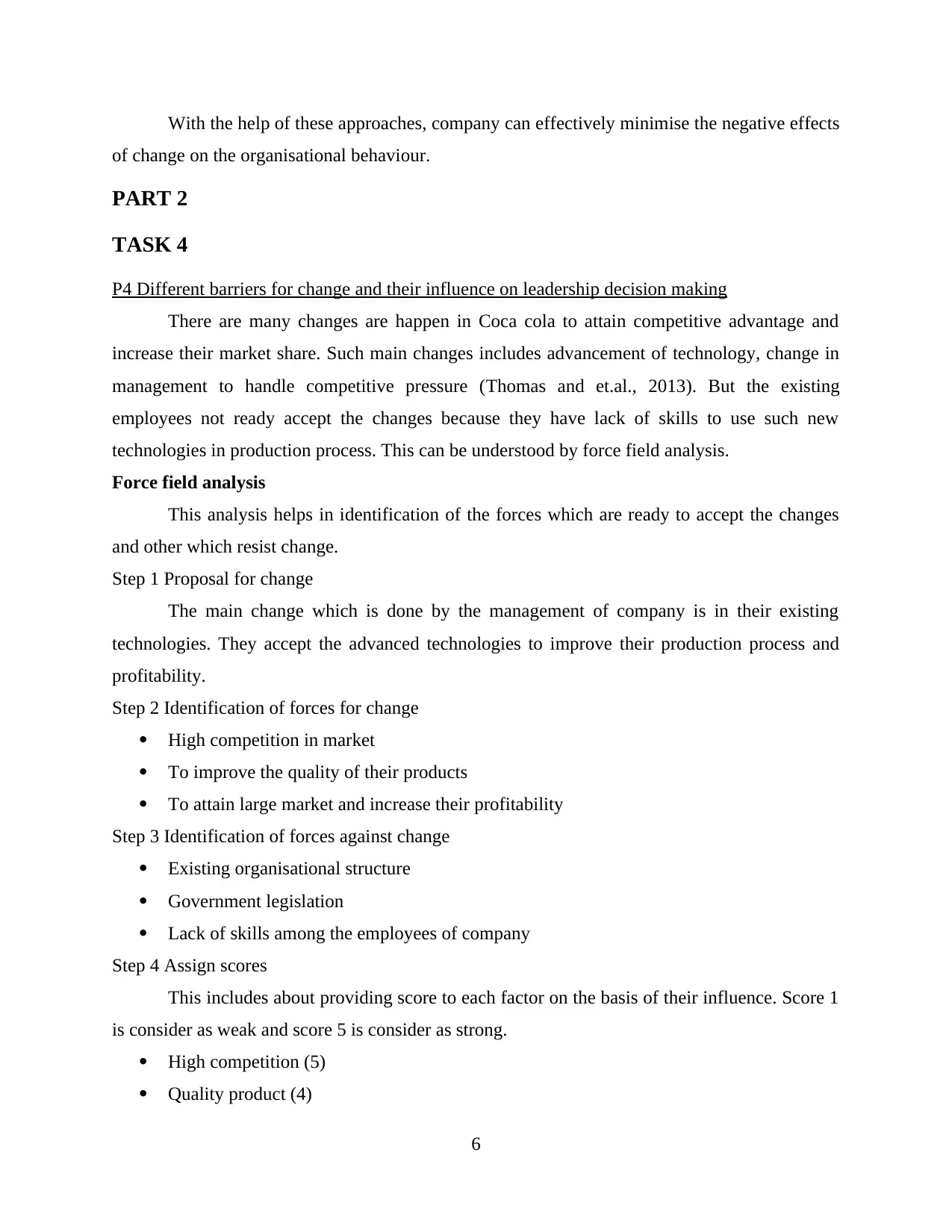
With the help of these approaches, company can effectively minimise the negative effects
of change on the organisational behaviour.
PART 2
TASK 4
P4 Different barriers for change and their influence on leadership decision making
There are many changes are happen in Coca cola to attain competitive advantage and
increase their market share. Such main changes includes advancement of technology, change in
management to handle competitive pressure (Thomas and et.al., 2013). But the existing
employees not ready accept the changes because they have lack of skills to use such new
technologies in production process. This can be understood by force field analysis.
Force field analysis
This analysis helps in identification of the forces which are ready to accept the changes
and other which resist change.
Step 1 Proposal for change
The main change which is done by the management of company is in their existing
technologies. They accept the advanced technologies to improve their production process and
profitability.
Step 2 Identification of forces for change
High competition in market
To improve the quality of their products
To attain large market and increase their profitability
Step 3 Identification of forces against change
Existing organisational structure
Government legislation
Lack of skills among the employees of company
Step 4 Assign scores
This includes about providing score to each factor on the basis of their influence. Score 1
is consider as weak and score 5 is consider as strong.
High competition (5)
Quality product (4)
6
of change on the organisational behaviour.
PART 2
TASK 4
P4 Different barriers for change and their influence on leadership decision making
There are many changes are happen in Coca cola to attain competitive advantage and
increase their market share. Such main changes includes advancement of technology, change in
management to handle competitive pressure (Thomas and et.al., 2013). But the existing
employees not ready accept the changes because they have lack of skills to use such new
technologies in production process. This can be understood by force field analysis.
Force field analysis
This analysis helps in identification of the forces which are ready to accept the changes
and other which resist change.
Step 1 Proposal for change
The main change which is done by the management of company is in their existing
technologies. They accept the advanced technologies to improve their production process and
profitability.
Step 2 Identification of forces for change
High competition in market
To improve the quality of their products
To attain large market and increase their profitability
Step 3 Identification of forces against change
Existing organisational structure
Government legislation
Lack of skills among the employees of company
Step 4 Assign scores
This includes about providing score to each factor on the basis of their influence. Score 1
is consider as weak and score 5 is consider as strong.
High competition (5)
Quality product (4)
6
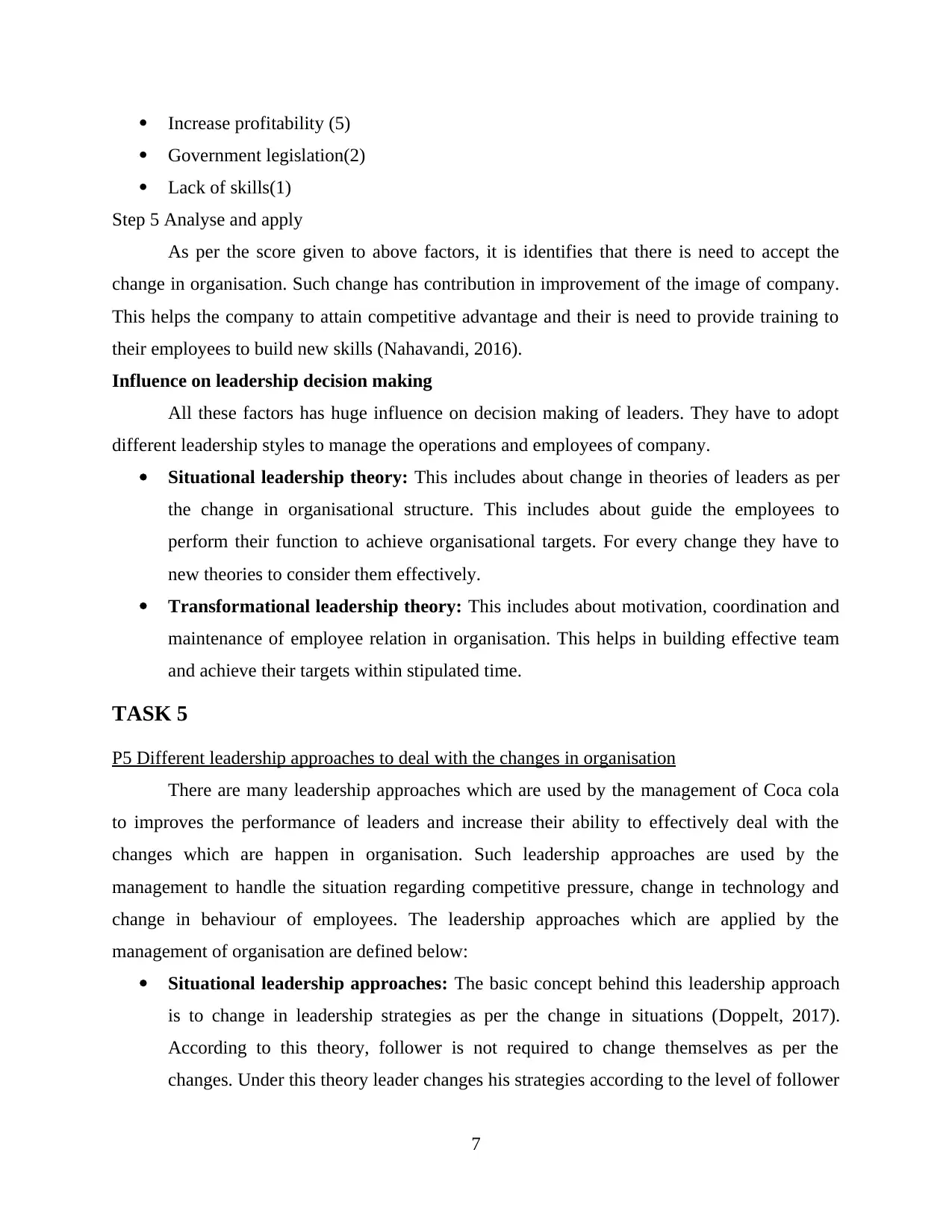
Increase profitability (5)
Government legislation(2)
Lack of skills(1)
Step 5 Analyse and apply
As per the score given to above factors, it is identifies that there is need to accept the
change in organisation. Such change has contribution in improvement of the image of company.
This helps the company to attain competitive advantage and their is need to provide training to
their employees to build new skills (Nahavandi, 2016).
Influence on leadership decision making
All these factors has huge influence on decision making of leaders. They have to adopt
different leadership styles to manage the operations and employees of company.
Situational leadership theory: This includes about change in theories of leaders as per
the change in organisational structure. This includes about guide the employees to
perform their function to achieve organisational targets. For every change they have to
new theories to consider them effectively.
Transformational leadership theory: This includes about motivation, coordination and
maintenance of employee relation in organisation. This helps in building effective team
and achieve their targets within stipulated time.
TASK 5
P5 Different leadership approaches to deal with the changes in organisation
There are many leadership approaches which are used by the management of Coca cola
to improves the performance of leaders and increase their ability to effectively deal with the
changes which are happen in organisation. Such leadership approaches are used by the
management to handle the situation regarding competitive pressure, change in technology and
change in behaviour of employees. The leadership approaches which are applied by the
management of organisation are defined below:
Situational leadership approaches: The basic concept behind this leadership approach
is to change in leadership strategies as per the change in situations (Doppelt, 2017).
According to this theory, follower is not required to change themselves as per the
changes. Under this theory leader changes his strategies according to the level of follower
7
Government legislation(2)
Lack of skills(1)
Step 5 Analyse and apply
As per the score given to above factors, it is identifies that there is need to accept the
change in organisation. Such change has contribution in improvement of the image of company.
This helps the company to attain competitive advantage and their is need to provide training to
their employees to build new skills (Nahavandi, 2016).
Influence on leadership decision making
All these factors has huge influence on decision making of leaders. They have to adopt
different leadership styles to manage the operations and employees of company.
Situational leadership theory: This includes about change in theories of leaders as per
the change in organisational structure. This includes about guide the employees to
perform their function to achieve organisational targets. For every change they have to
new theories to consider them effectively.
Transformational leadership theory: This includes about motivation, coordination and
maintenance of employee relation in organisation. This helps in building effective team
and achieve their targets within stipulated time.
TASK 5
P5 Different leadership approaches to deal with the changes in organisation
There are many leadership approaches which are used by the management of Coca cola
to improves the performance of leaders and increase their ability to effectively deal with the
changes which are happen in organisation. Such leadership approaches are used by the
management to handle the situation regarding competitive pressure, change in technology and
change in behaviour of employees. The leadership approaches which are applied by the
management of organisation are defined below:
Situational leadership approaches: The basic concept behind this leadership approach
is to change in leadership strategies as per the change in situations (Doppelt, 2017).
According to this theory, follower is not required to change themselves as per the
changes. Under this theory leader changes his strategies according to the level of follower
7
⊘ This is a preview!⊘
Do you want full access?
Subscribe today to unlock all pages.

Trusted by 1+ million students worldwide
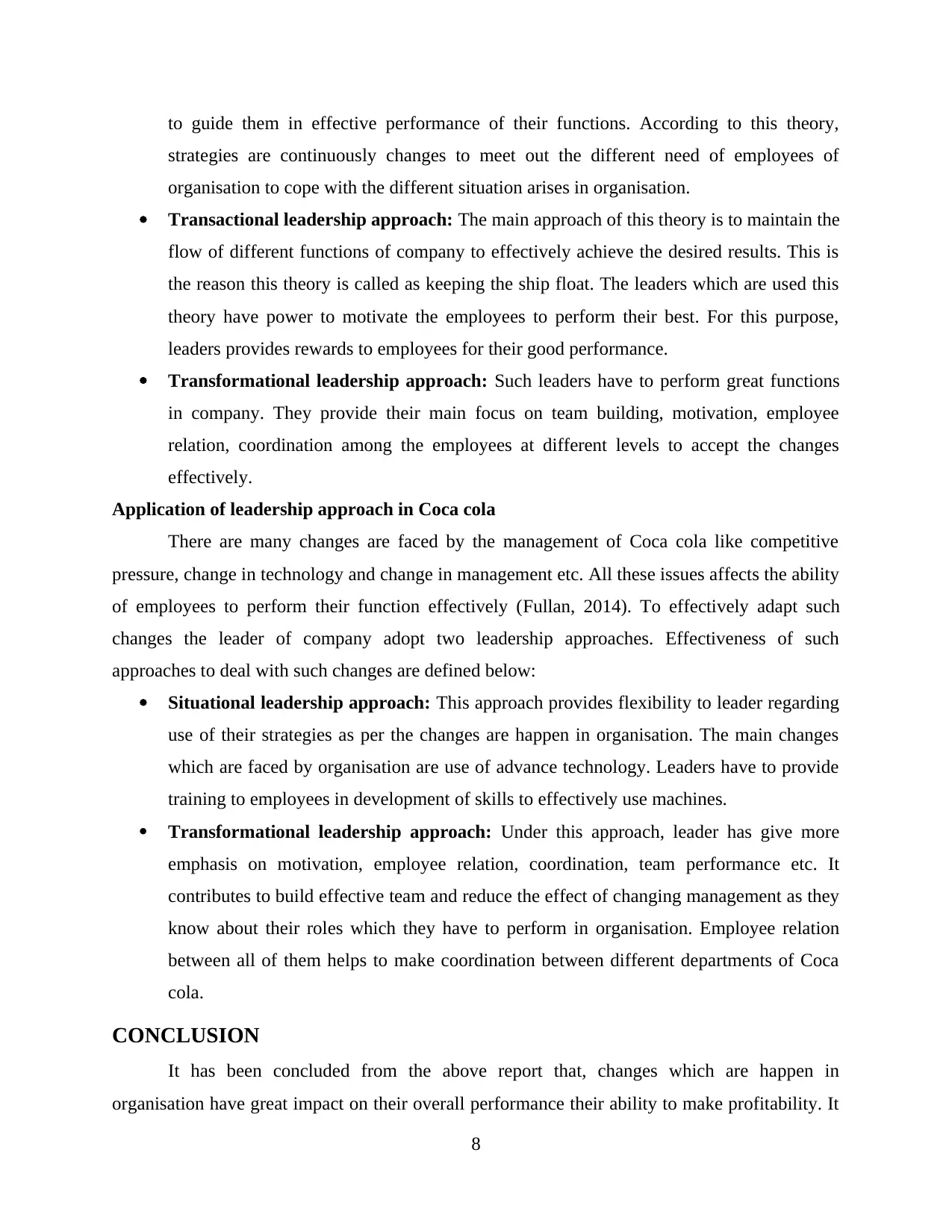
to guide them in effective performance of their functions. According to this theory,
strategies are continuously changes to meet out the different need of employees of
organisation to cope with the different situation arises in organisation.
Transactional leadership approach: The main approach of this theory is to maintain the
flow of different functions of company to effectively achieve the desired results. This is
the reason this theory is called as keeping the ship float. The leaders which are used this
theory have power to motivate the employees to perform their best. For this purpose,
leaders provides rewards to employees for their good performance.
Transformational leadership approach: Such leaders have to perform great functions
in company. They provide their main focus on team building, motivation, employee
relation, coordination among the employees at different levels to accept the changes
effectively.
Application of leadership approach in Coca cola
There are many changes are faced by the management of Coca cola like competitive
pressure, change in technology and change in management etc. All these issues affects the ability
of employees to perform their function effectively (Fullan, 2014). To effectively adapt such
changes the leader of company adopt two leadership approaches. Effectiveness of such
approaches to deal with such changes are defined below:
Situational leadership approach: This approach provides flexibility to leader regarding
use of their strategies as per the changes are happen in organisation. The main changes
which are faced by organisation are use of advance technology. Leaders have to provide
training to employees in development of skills to effectively use machines.
Transformational leadership approach: Under this approach, leader has give more
emphasis on motivation, employee relation, coordination, team performance etc. It
contributes to build effective team and reduce the effect of changing management as they
know about their roles which they have to perform in organisation. Employee relation
between all of them helps to make coordination between different departments of Coca
cola.
CONCLUSION
It has been concluded from the above report that, changes which are happen in
organisation have great impact on their overall performance their ability to make profitability. It
8
strategies are continuously changes to meet out the different need of employees of
organisation to cope with the different situation arises in organisation.
Transactional leadership approach: The main approach of this theory is to maintain the
flow of different functions of company to effectively achieve the desired results. This is
the reason this theory is called as keeping the ship float. The leaders which are used this
theory have power to motivate the employees to perform their best. For this purpose,
leaders provides rewards to employees for their good performance.
Transformational leadership approach: Such leaders have to perform great functions
in company. They provide their main focus on team building, motivation, employee
relation, coordination among the employees at different levels to accept the changes
effectively.
Application of leadership approach in Coca cola
There are many changes are faced by the management of Coca cola like competitive
pressure, change in technology and change in management etc. All these issues affects the ability
of employees to perform their function effectively (Fullan, 2014). To effectively adapt such
changes the leader of company adopt two leadership approaches. Effectiveness of such
approaches to deal with such changes are defined below:
Situational leadership approach: This approach provides flexibility to leader regarding
use of their strategies as per the changes are happen in organisation. The main changes
which are faced by organisation are use of advance technology. Leaders have to provide
training to employees in development of skills to effectively use machines.
Transformational leadership approach: Under this approach, leader has give more
emphasis on motivation, employee relation, coordination, team performance etc. It
contributes to build effective team and reduce the effect of changing management as they
know about their roles which they have to perform in organisation. Employee relation
between all of them helps to make coordination between different departments of Coca
cola.
CONCLUSION
It has been concluded from the above report that, changes which are happen in
organisation have great impact on their overall performance their ability to make profitability. It
8
Paraphrase This Document
Need a fresh take? Get an instant paraphrase of this document with our AI Paraphraser
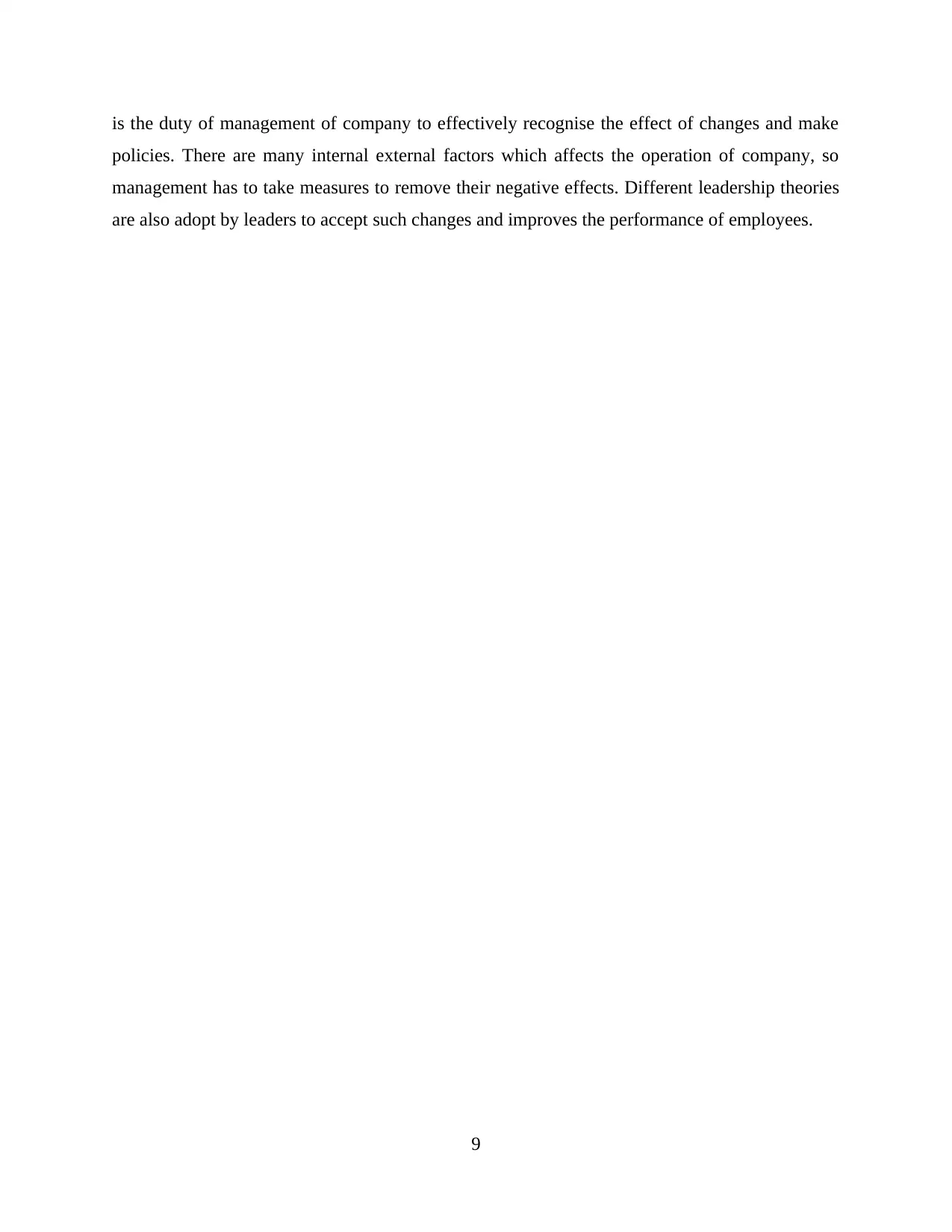
is the duty of management of company to effectively recognise the effect of changes and make
policies. There are many internal external factors which affects the operation of company, so
management has to take measures to remove their negative effects. Different leadership theories
are also adopt by leaders to accept such changes and improves the performance of employees.
9
policies. There are many internal external factors which affects the operation of company, so
management has to take measures to remove their negative effects. Different leadership theories
are also adopt by leaders to accept such changes and improves the performance of employees.
9
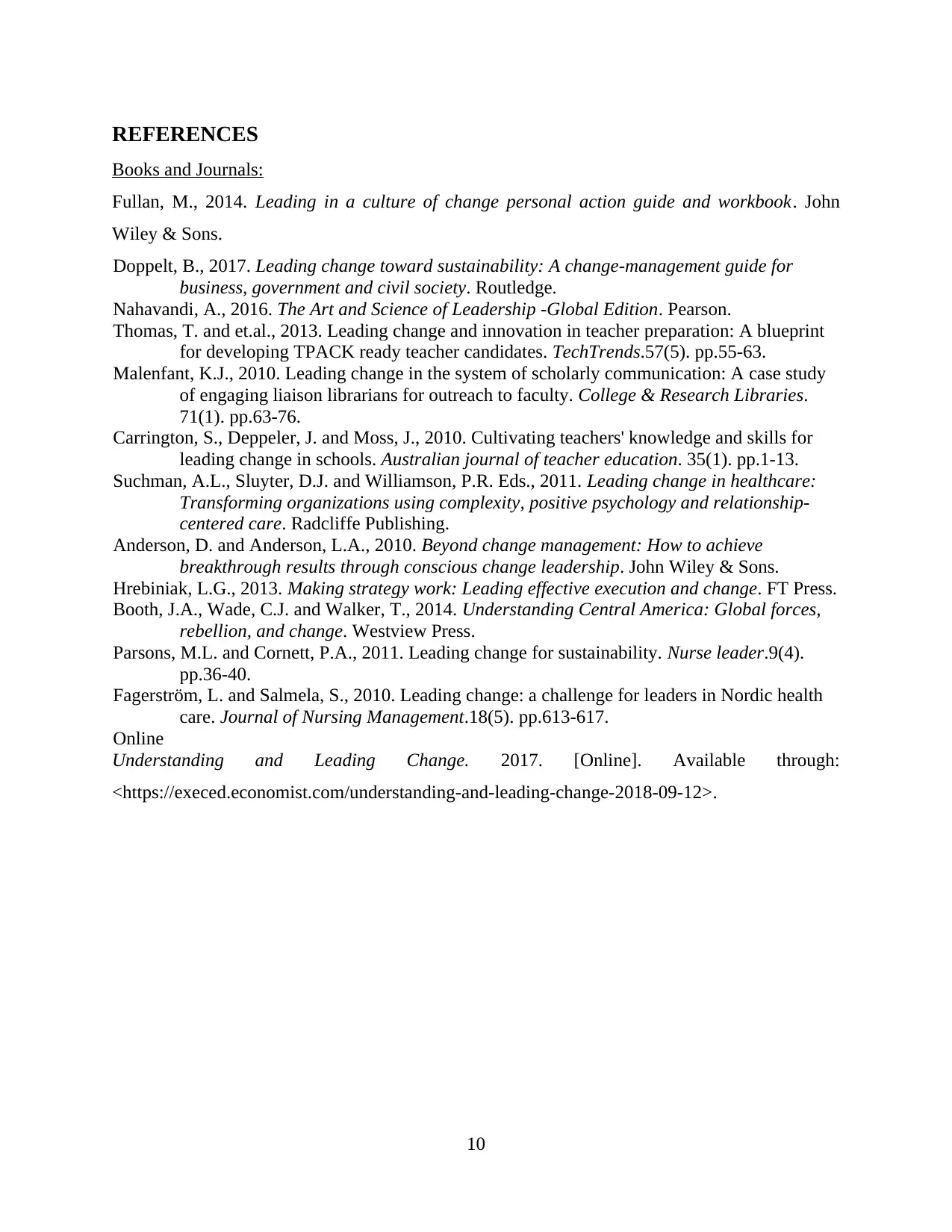
REFERENCES
Books and Journals:
Fullan, M., 2014. Leading in a culture of change personal action guide and workbook. John
Wiley & Sons.
Doppelt, B., 2017. Leading change toward sustainability: A change-management guide for
business, government and civil society. Routledge.
Nahavandi, A., 2016. The Art and Science of Leadership -Global Edition. Pearson.
Thomas, T. and et.al., 2013. Leading change and innovation in teacher preparation: A blueprint
for developing TPACK ready teacher candidates. TechTrends.57(5). pp.55-63.
Malenfant, K.J., 2010. Leading change in the system of scholarly communication: A case study
of engaging liaison librarians for outreach to faculty. College & Research Libraries.
71(1). pp.63-76.
Carrington, S., Deppeler, J. and Moss, J., 2010. Cultivating teachers' knowledge and skills for
leading change in schools. Australian journal of teacher education. 35(1). pp.1-13.
Suchman, A.L., Sluyter, D.J. and Williamson, P.R. Eds., 2011. Leading change in healthcare:
Transforming organizations using complexity, positive psychology and relationship-
centered care. Radcliffe Publishing.
Anderson, D. and Anderson, L.A., 2010. Beyond change management: How to achieve
breakthrough results through conscious change leadership. John Wiley & Sons.
Hrebiniak, L.G., 2013. Making strategy work: Leading effective execution and change. FT Press.
Booth, J.A., Wade, C.J. and Walker, T., 2014. Understanding Central America: Global forces,
rebellion, and change. Westview Press.
Parsons, M.L. and Cornett, P.A., 2011. Leading change for sustainability. Nurse leader.9(4).
pp.36-40.
Fagerström, L. and Salmela, S., 2010. Leading change: a challenge for leaders in Nordic health
care. Journal of Nursing Management.18(5). pp.613-617.
Online
Understanding and Leading Change. 2017. [Online]. Available through:
<https://execed.economist.com/understanding-and-leading-change-2018-09-12>.
10
Books and Journals:
Fullan, M., 2014. Leading in a culture of change personal action guide and workbook. John
Wiley & Sons.
Doppelt, B., 2017. Leading change toward sustainability: A change-management guide for
business, government and civil society. Routledge.
Nahavandi, A., 2016. The Art and Science of Leadership -Global Edition. Pearson.
Thomas, T. and et.al., 2013. Leading change and innovation in teacher preparation: A blueprint
for developing TPACK ready teacher candidates. TechTrends.57(5). pp.55-63.
Malenfant, K.J., 2010. Leading change in the system of scholarly communication: A case study
of engaging liaison librarians for outreach to faculty. College & Research Libraries.
71(1). pp.63-76.
Carrington, S., Deppeler, J. and Moss, J., 2010. Cultivating teachers' knowledge and skills for
leading change in schools. Australian journal of teacher education. 35(1). pp.1-13.
Suchman, A.L., Sluyter, D.J. and Williamson, P.R. Eds., 2011. Leading change in healthcare:
Transforming organizations using complexity, positive psychology and relationship-
centered care. Radcliffe Publishing.
Anderson, D. and Anderson, L.A., 2010. Beyond change management: How to achieve
breakthrough results through conscious change leadership. John Wiley & Sons.
Hrebiniak, L.G., 2013. Making strategy work: Leading effective execution and change. FT Press.
Booth, J.A., Wade, C.J. and Walker, T., 2014. Understanding Central America: Global forces,
rebellion, and change. Westview Press.
Parsons, M.L. and Cornett, P.A., 2011. Leading change for sustainability. Nurse leader.9(4).
pp.36-40.
Fagerström, L. and Salmela, S., 2010. Leading change: a challenge for leaders in Nordic health
care. Journal of Nursing Management.18(5). pp.613-617.
Online
Understanding and Leading Change. 2017. [Online]. Available through:
<https://execed.economist.com/understanding-and-leading-change-2018-09-12>.
10
⊘ This is a preview!⊘
Do you want full access?
Subscribe today to unlock all pages.

Trusted by 1+ million students worldwide
1 out of 12
Related Documents
Your All-in-One AI-Powered Toolkit for Academic Success.
+13062052269
info@desklib.com
Available 24*7 on WhatsApp / Email
![[object Object]](/_next/static/media/star-bottom.7253800d.svg)
Unlock your academic potential
Copyright © 2020–2025 A2Z Services. All Rights Reserved. Developed and managed by ZUCOL.




